Ocean Adventures With VR
Traveling the world can be added into a lot of global goals to improve the learning experience; with the assistance of VR traversing the world becomes easy. Exposure to more parts of the world can dramatically help with education towards SDG 14, Life Below Water. VR and its ability to connect with and tour areas of the world without having to go there physically allows for a more interactive and immersive learning experience.
Thanks to computers and advancements in technology we are able to connect with people through applications like Skype and through this we can talk with experts from around the world and connect with different communities. The ability to connect to others also allows for a greater number of people working towards one goal.
There are resources for educating those on Global Goals and they provide a lot of good information in the forms of videos, PDFs, and classroom activities, however, I think that VR can greatly improve the learning experience of SDG 14 by putting people in the underwater world. By giving this experience we can see different species of marine life, ranging from animals to plants, and go on to learn about their importance. VR gives a more personal experience to learning in my opinion. Instead of students recalling that they looked at a fish, or cephalopod, or the coral reef, in a textbook, they can instead recall the time they were transported to the ocean and got to witness how these organisms lived.

Youtube 360 Videos are a great way to implement learning about SDG 14 with VR. These videos allow the viewer to take control of what they are looking at. It is an incredible experience to spin around in the depths of the ocean. Thanks to the videographers and cameras used to capture the footage it feels like you are actually down in the waters exploring by yourself. A video I liked was, 360° Underwater National Park by National Geographic; this video explores the ocean, showing the coral and sea turtles around Buck Island, the first American protected marine monument.

Journey Into the Deep Sea – VR, is another video from national geographic that allows for 360° control as you learn about the Coral Reef and its importance to the ocean ecosystem. The video talks about the Coral Bleeching that happened in 2016 and emphasizes how important the Reef is and how protecting the ocean is a global movement.
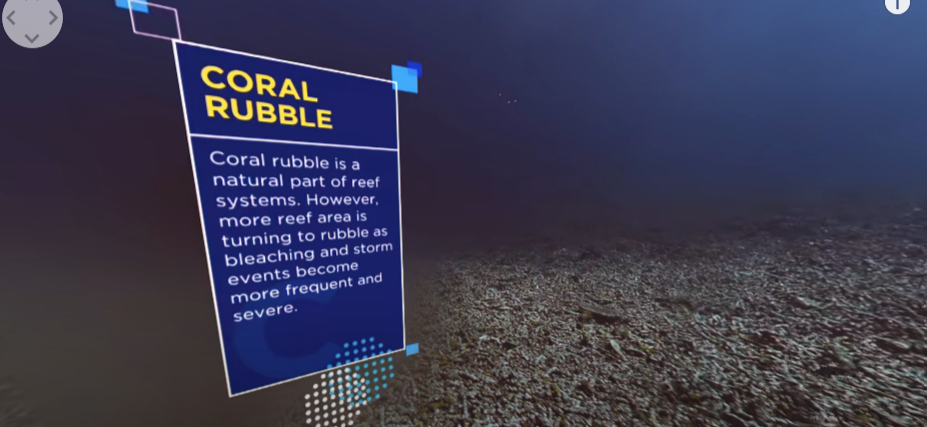
Another Video that I liked was Swimming with Giants 360. This video from, the American Museum of Natural History, put you in the middle of the ocean and has a variety of animal swim by as you look around and follow where they go.
360° Sea Plastic is a video from, the Jetlagged – Ocean Films and Adventures, about ocean pollution. In it they talked about the fragile ocean ecosystem and how it was created to be perfectly balanced. Now the production of plastic has increased, causing an equal increase in plastic waste, that unfortunately, ends up in our water and that puts the ecosystem in danger. This video shines a light on the grim reality of the plastic problem and how we need to band together in order to make a difference. I think this video is great for showing a real problem the oceans and water ways face by putting the viewer in areas where the improper disposal of plastic waste is negatively impacting some communities.
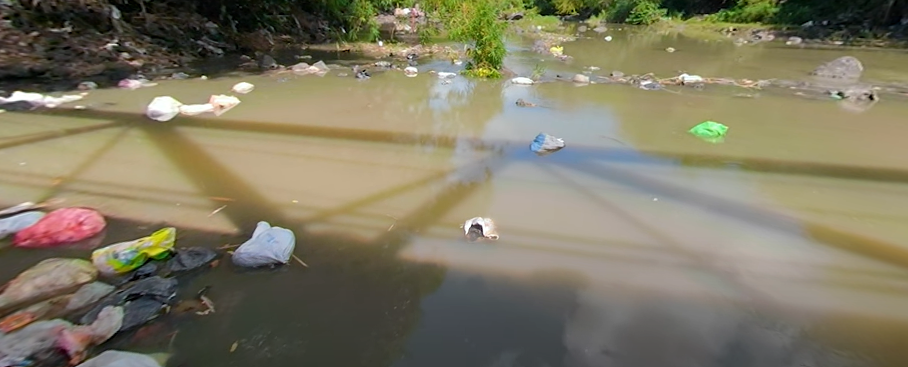
I found the National Marine Sanctuaries website while looking into VR technology and how it can be applied to teach about Ocean life. When you get to the website your able to select Education under the Learn tab. This leads to even more choices and gives resources to teachers and students. One in particular is a link to 360° virtual reality lessons.
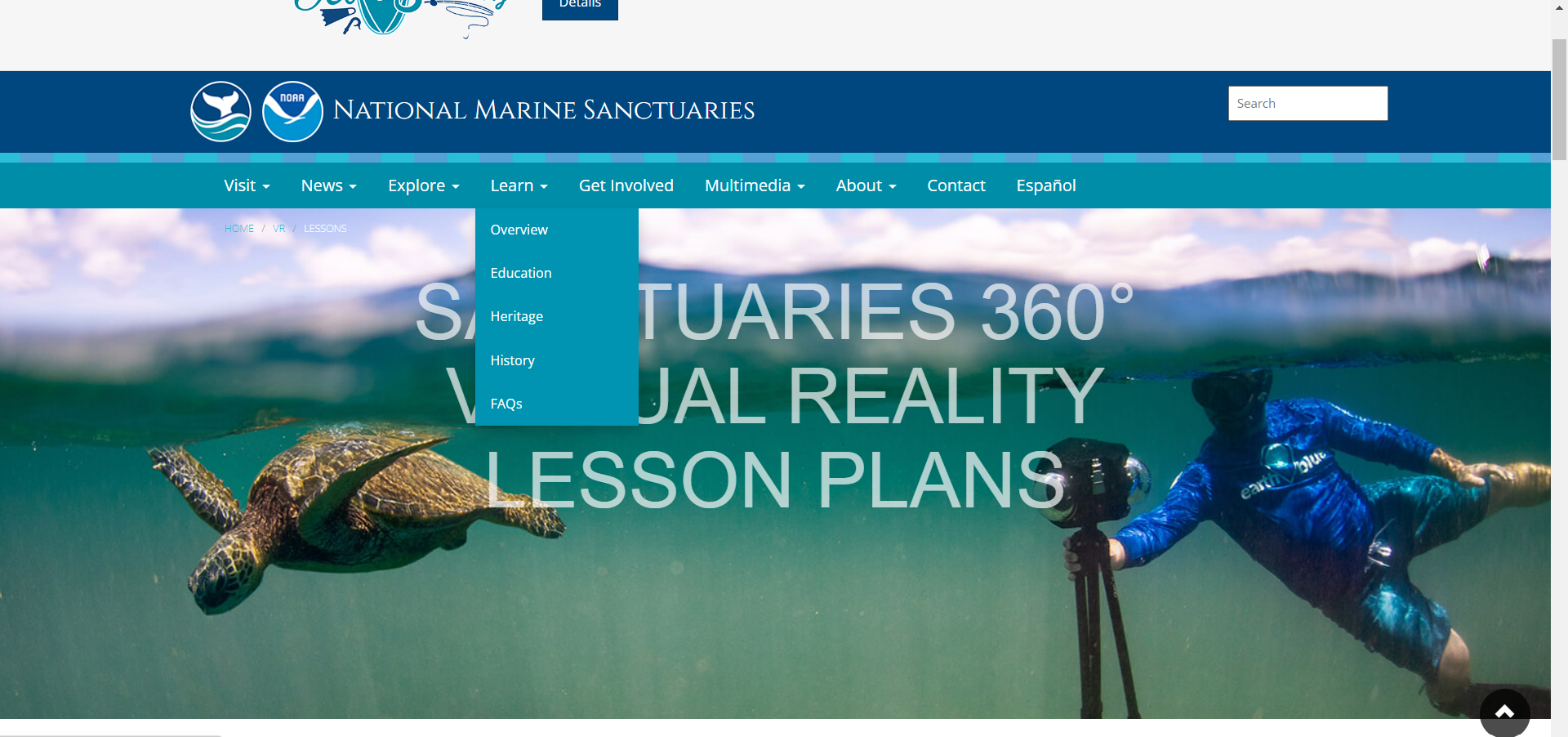

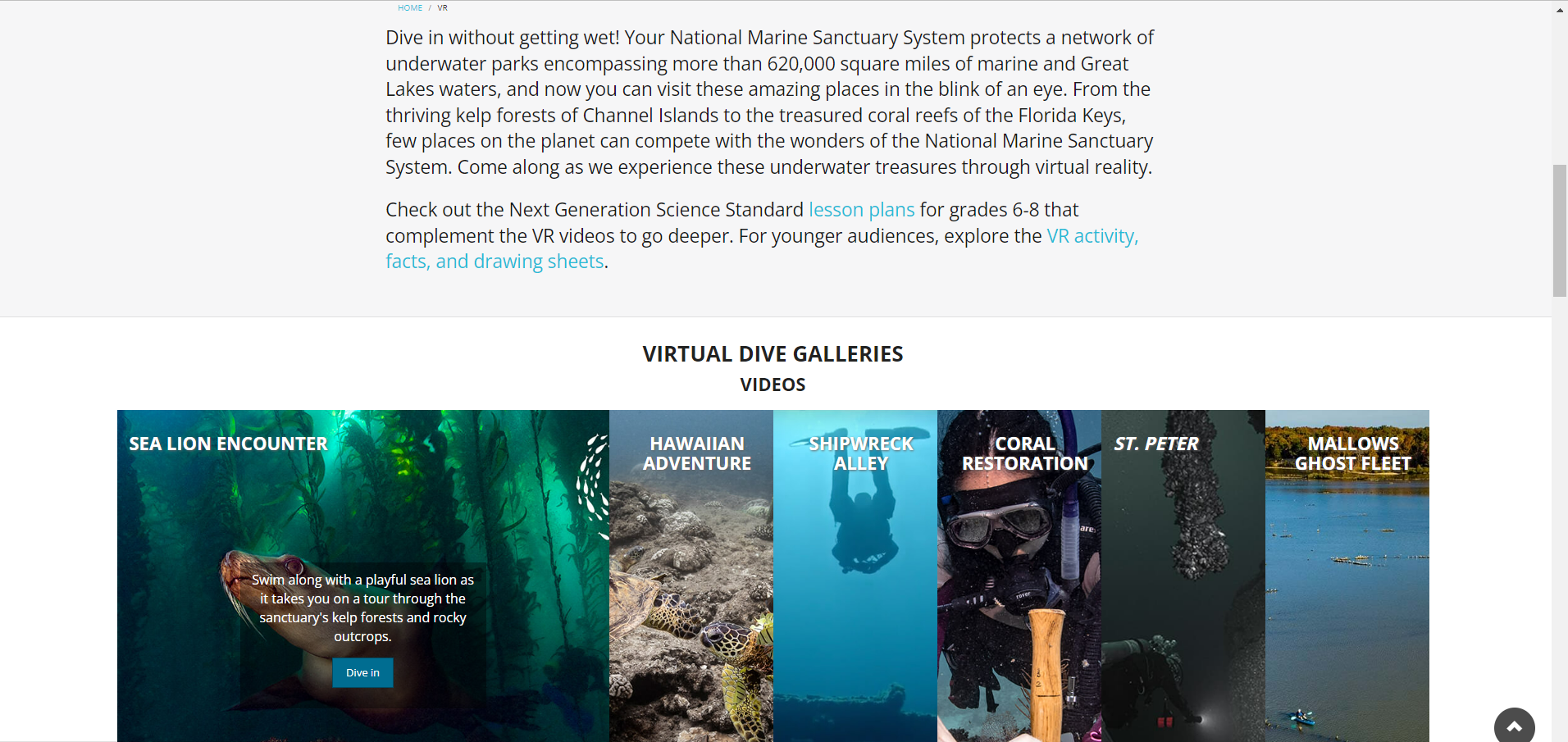
Each of the six 360 video that are offered is around three to four minutes long. There are also 360 pictures that the website offers; these pictures are of different bays and coast and other areas of the ocean. They are not partnered with the lesson plans, but the images are beautiful, give small sentences to inform the viewer about what they are seeing, and worth checking out in my opinion. After watching the video and learning about different areas of the ocean or the animals that inhabit it, the lesson plan can be used. The lesson plan below is paired with a 360 video about sea lions. The lesson features discussions about the environment the animals live in, different plants in the area, and the different adaptations the animals needed to survive in the cold waters.
After learned about the sea lions and how they live in cold water student will participate in an experiment that demonstrates how insulation works. Using two jars on hot water, one will be insulated with materials that students brainstorm about using. After they come up with ideas and run their experiment, they given time to discuss their finding with their group and the class.
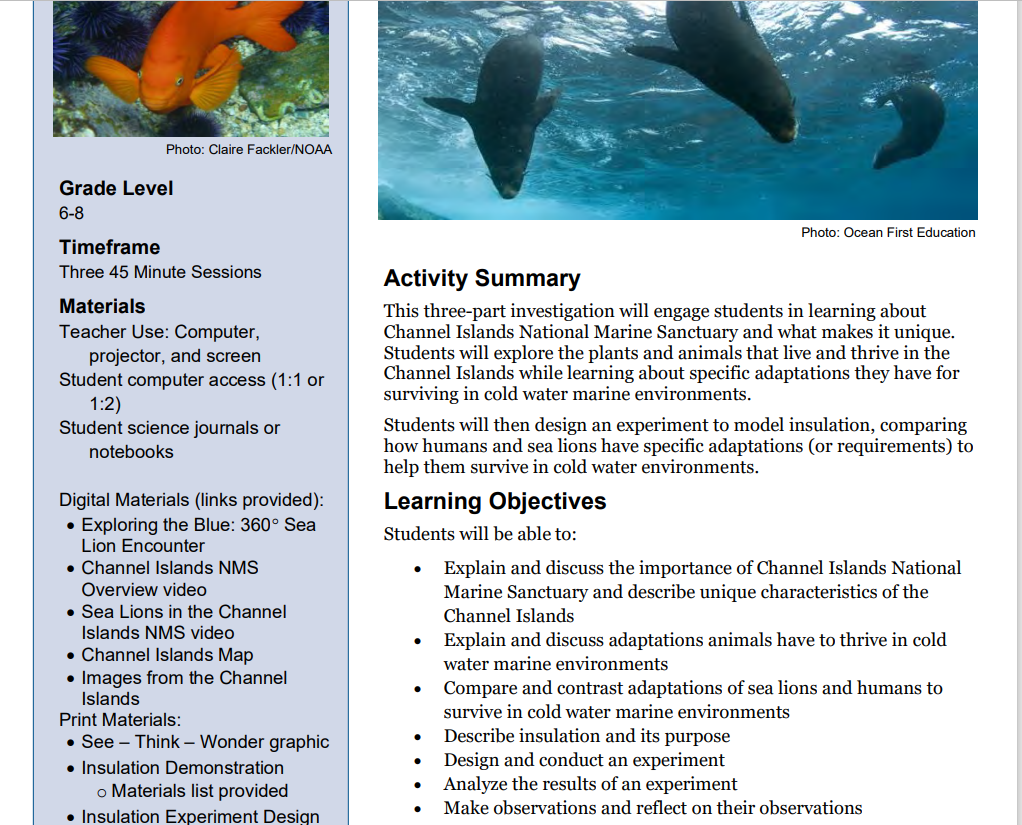
The 360° videos offered on YouTube are amazing and I really loved my experience with them. I think they can add a lot to any educational experience by allowing learners to get closer to the topics at hand. The National Geographic YouTube channel has a lot of these 360° videos and the topics are varied. The National Marine Sanctuaries website took the 360 videos a step further by adding their own lesson plans and activities to give students and teachers and deeper understand of what they just watched. In an article from Structural Learning.com, they explain that VR in education offers students immersive environments to practices their skills in scenarios that are controlled. The use of VR also enhances the learning experience by increasing engagement and retention of information; this happens because the student is experiencing what they are learning about instead of hearing about it. The medium of VR and 360 videos also allow learners to be put into all types of situations, allowing for deeper emotional connections with the source material and developing empathy by taking someone else’s perspective. A perfect example of this is when I was watching the 360° Sea Plastic video. Beaches near me are pretty clean but, I was put into an area where they water ways were filled with trash and I was upset by what the plastic trash was doing to the environment. I’m personally looking forward to the watching 360 videos get better and better and seeing how they can be implemented to enhance education.
WE Teachers and the Bullying Module
Growing up my school had a pretty good no bullying policy. It still happened, but for the most part it was a good environment to learn in. I would like to continue this anti bullying policy and the We Teachers Bullying Module is a good tool for doing exactly that. The module first goes over terms and statistics about bullying so that everyone can have the same understanding of what is being talked about. There are many types of bullying, like verbal, social, and physical, and then there are types of bullying that are more specific like cyberbullying, sexual harassment, and discriminatory bullying. Bullying is a major problem because it has negatively impacted everyone involved which is why it is important to stop it as soon as possible.
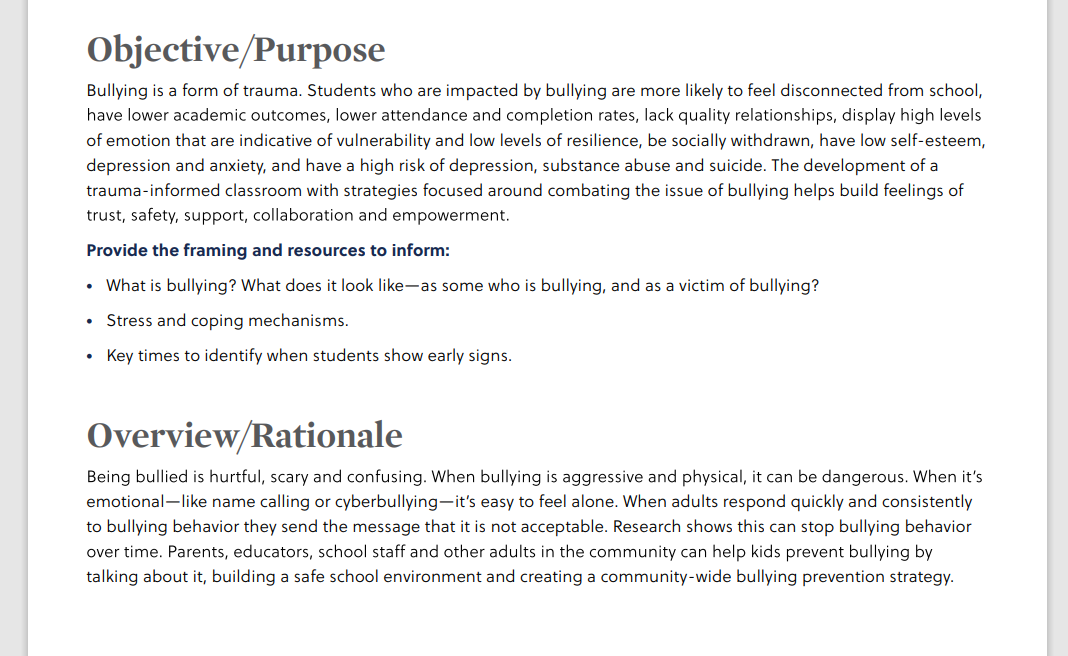
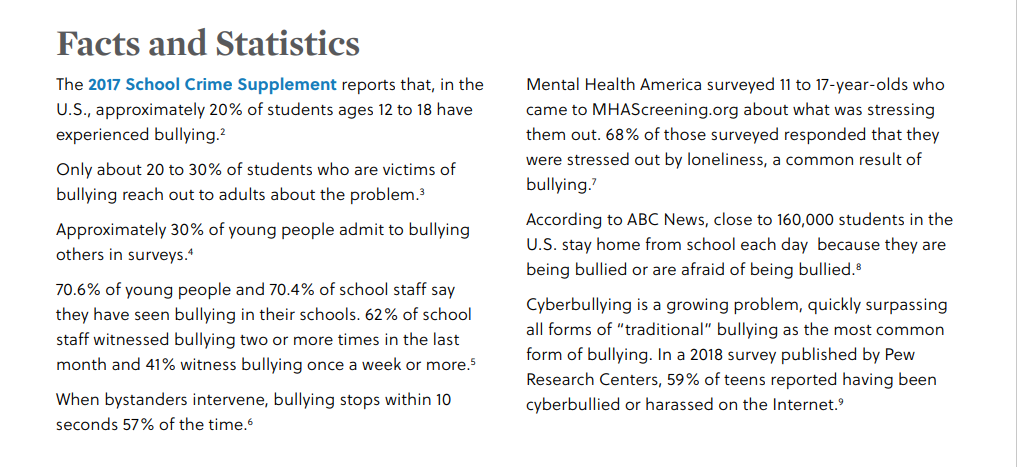
The module gives advice on preventing bullying like identifying bullying hot spots as a way to stop it from taking place. It could be a certain bathroom, hallway, or somewhere outside on school grounds. Monitoring these spaces makes sure that the perpetrator and the victim of bullying know they are being seen if something were to happen.
Some of the ways they suggest taking action is by updating the policies and procedures are bullying and talking to the parents. They also giving some insights on Zero Tolerance Policies and how some actions that can be taken to prevent bullying could make it worse. Something I thought was important that the module stressed was not labeling the bully. Giving labels to someone can cause them to act a certain way, instead it tells educators and facility members to tell students that are participating in bullying that “we don’t treat people that way” or that “this behavior is not acceptable.” This specific way of phrasing your message to the student makes it so their behavior is being addressed as the problem and not themselves.
For teachers, the module goes over ways to stop bullying before it starts. You can do this by establishing a culture of inclusion, setting a ton of respect, developing rules with the students, being a good role model, rewarding and acknowledging good behavior, and having meetings with the class. The module also gives advice to teachers on what to do when a student comes to you with an issue about bullying or if you witness bullying.
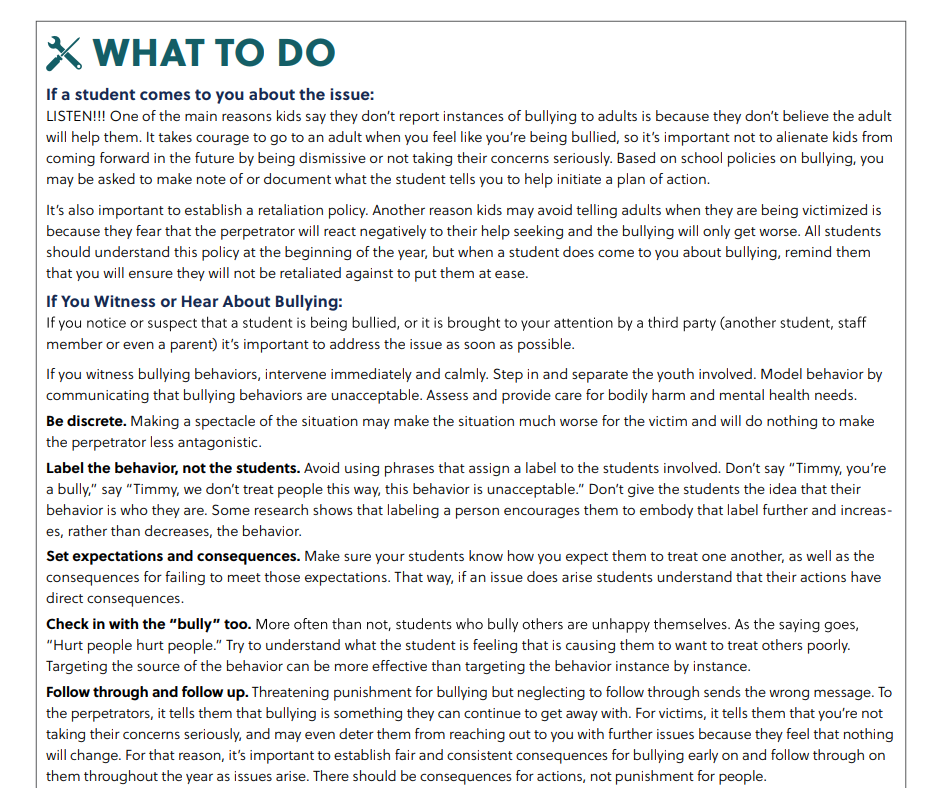
This module also comes with worksheets and activities so you can go over what you’ve taught your class about bullying. It also offers worksheets on different scenarios that might occur and had a perspective taking worksheet for educators. I think some of the best resources the module offers are discussions for understanding bullying, with questions to get conversations started, and a section on how to introduce the topic to teenagers and getting them to care about the issue.

I think that the WE Teacher Modules are incredible resources that can offer a lot of help. I’ve always wanted to be a teacher that could help prevent bullying, but I wasn’t sure how I was going to actually accomplish that goal. There were the obvious steps to take like talking to the class and telling them what is expected from them, and also stopping anything I saw by intervening, but other than that I was kind of lost. This module will really help me implement strategies in the classroom so that the learning environment is safe for everyone.
Smithsonian, the National Museum of Natural History
On my virtual tour I went to the Smithsonian. This museum is incredible. First, I went left to an area that housed a lot of information and exhibits on mammals. Seeing taxidermy animals that are the size they would be in the wild is very cool, most were set up in scenes that would be observe in the wild, like putting animals around a watering hole. I loved the facts about each exhibit and enjoyed that it showed mammals from all over the world.
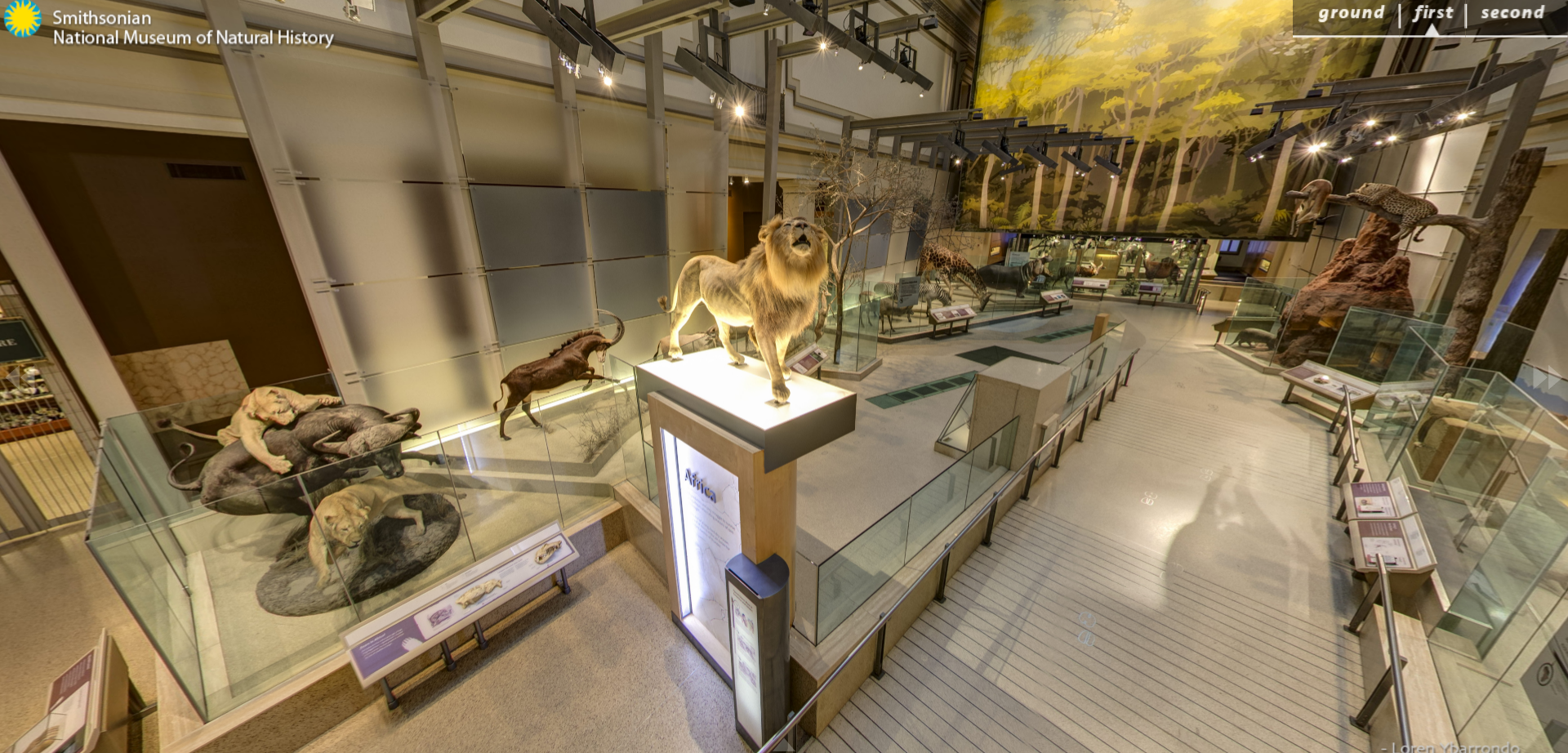
Next, I went to the Human Origin exhibit and saw different things like symbols and tools that humans created, what humans ate in the past, the different species of human that existed, and how human evolved over the millions of years. The exhibits very interesting to look at in my opinion because it was looking at us but millions of years ago.
Next, I went to the Ocean Hall. The ocean is an amazing place but also terrifying to me because it’s so big and unexplored. I’ve also thought Jaws and the Kraken were super scary stories about powerful creatures that live in the ocean. The exhibit showed the different animals that live in the ocean and had information on migration habits, how the animals communicate, the communities they for and how they live, and more. Different habitats were shown like the coral reefs and shallow waters/shore. I think the diversity of the animals was my favorite part and how wild some of them can look.
Next, I went to the African Voices which showed different art and cultural aspects from Africa. The areas were broken up into time periods, showing the differences between the times, starting in 200 B.C.E. and going until the modern day. I liked this part of the museum because it showed how other cultures live and create and impact the world.
The last part I checked out was the Deep Time Exhibit. This exhibit went over the past of the world and seeing how the world is connected. The dinosaurs’ fossils at the start were awesome. Then it does it the evolution of land animals and early ocean life. This part of the tour has a new feature where you can click one the informational plaques or smaller display allowing for a better view. Earlier you just had to zoom in on what you wanted to see, which honestly was better than expected, but this feature makes it so much easier to see what you are trying to look at. The exhibit covers so much about the distant past and the events that impacted the world and the animal living in it. I would 100% check out this museum tour, it was so interesting and easy to navigate.
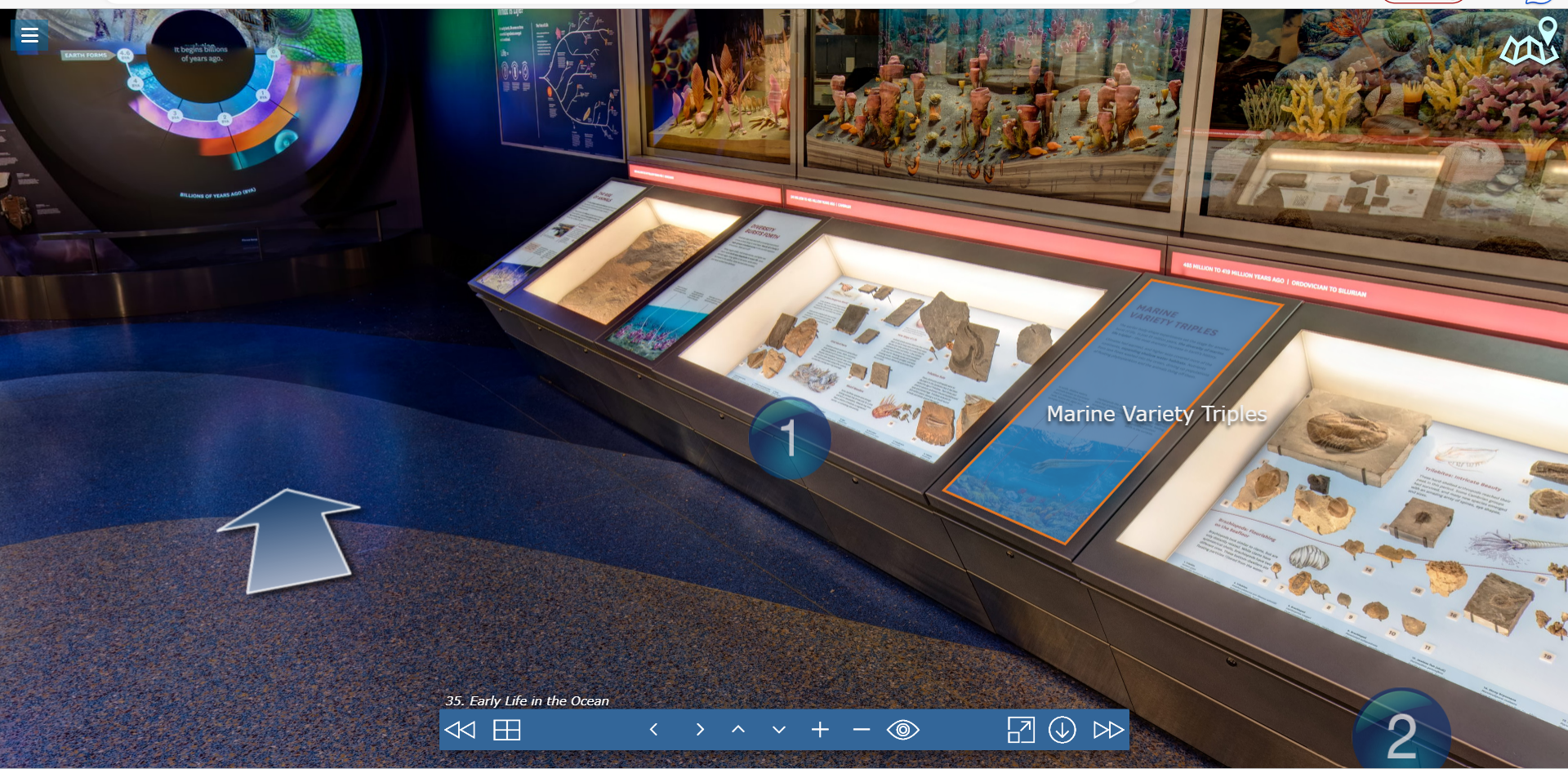
I lost My Body
I Lost My Body was the movie that I decided to watch this week. This films original audio is French and played with English subtitles. (Contains spoilers!)
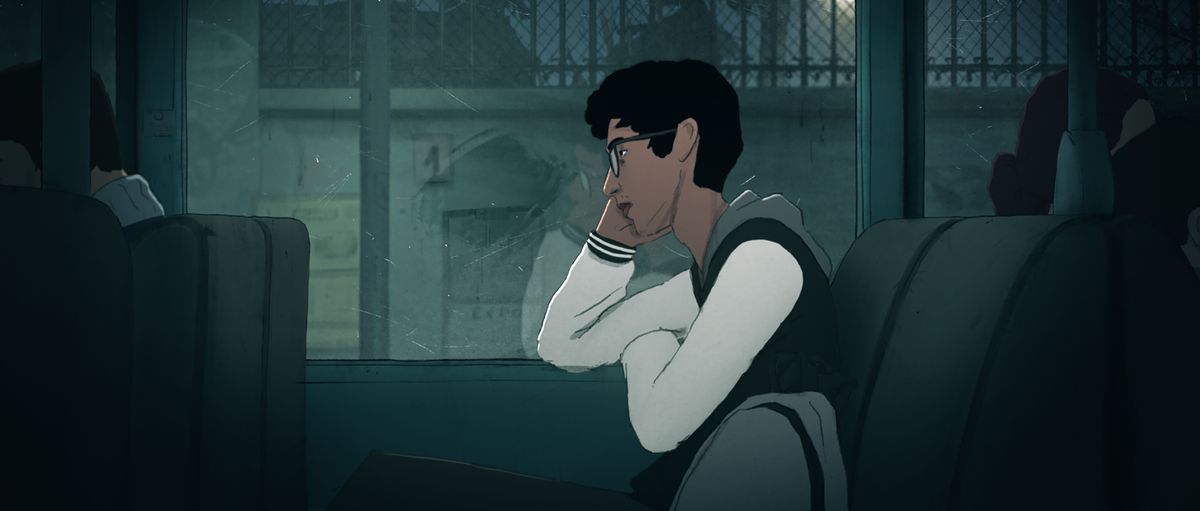
This movie was a trip. You follow the main character and a severed hand (Spoiler alert) it’s his severed hand. As they move about Paris and go through life. The movie does have repetitive imagery in the use of a fly, and astronaut, a goat, and I’m sure there are more but those are the ones I took notice of.
The movie is set in London. Originally the main character lives with his parents and then is taken in by a different family after his parents die in a car accident. They all dress modernly, all of the characters do; Outfits come in all shapes sizes and colors. There are suits, dresses, hoodies, tee shirts, pants, and work clothes.
Because the movie takes place in a big city, and the times are modern it doesn’t look very different when compared to cities in the U.S. The multiple setting of the movie consists of his family house, his guardians house, the trains/subway, the library, a pizza shop, a carpentry shop, the rooftops of the neighborhood, and an apartment building lobby. There is also the various setting from the point of view of a hand. Most of these are outside or in building that the hand has ended up in while attempting to reunite with Nauofel. The building in the movie, for the most part, are made out of bricks. There is also antenna on top of the roofs, for phone service of cable television.

The food that they eat and mention as well as the beverages they drink are all very common in America. Nauofel works at a pizza shop delivering food. Later in the movie he eats hot dogs and baked bean. Towards the end of the movie Gabriel talks about getting sushi instead of pizza because the pizza ended up getting cold. Again, I think that this is because the movie is set in more modern times.
The characters in the movie are all working class citizens. Nauofel grows up with his parents, they spend a lot of time with him, are very supportive when he tells them he wants to be an astronaut. They teach him how to play and instrument and they enjoy playing them together. Once his parents die, he is taken in by a man and his son. His adopted father is not very close to Nauofel and their only interactions are Nauofel giving him rent and Nauofel telling his adopted father that he is leaving because of a job opportunity. His brother is an angsty teen/ young adult and Nauofel doesn’t have a good relationship with him. Gabrielle is another main character, she meets Nauofel when he delivers a pizza to her one night, after a conversation through a speaker in the lobby Nauofel tracks her down. Gabrielle is a kind young woman who keeps to herself and works at the library. She wears headphones to show that she doesn’t want to really speak with people she doesn’t know. He ends up following her to a carpentry shop and here he meets her uncle. Gabriella takes care of her uncle and brings him medicine. Her uncle ends up giving Nauofel an internship and allows him to learn carpentry. He is a kind man who gives Nauofel a chance to work with him and somewhere to live after finding out that he lost both of his parents.
There are not many cultural differences that I could find. One thing I noticed was that a lot of character smoked cigarettes, the drinking age was younger so we saw some character drinking alcohol that they would be in the United States. In the United States smoking has fades away and I think for my generation is less common. Another thing that I noticed was how the movie focused on music. In the beginning Nauofel’s mother plays the violin and teaches him how to play the piano. Later in the movie a seeing eye dog grabs the severed hand and brings it to an apartment building. The blind man living in the apartment also plays the piano. Music is also represented with Gabrielle wearing headphones and Nauofel using a tape recorder to listen to events from his past.
The similarities are endless, the city landscape, the buildings, the transportation systems (riding bikes, taking the train), the clothes that are worn, all of this is very similar to everything you could see in America.
I enjoyed the movie, but the overall plot was confusing. The values of characters were hard to determine because for some stretched of the movie, we don’t follow the main characters, instead we follow his hand. The main character is obsessed with connecting to Gabrielle, going as far as working for her uncle and waiting weeks to reveal that he knew her from a pizza delivery. His values seem to be love but it’s hard to pin down what really drives the character. After Gabrielle find out he has been doing everything in order to get close to her very upset and reveals that she values family, while questioning Nauaofel’s motives she brings up the fact that her uncle has been struggling with his health and wonders if Nauofel even cares about him or the job opportunity he was given. I definitely recommend watching this movie. It was very interesting and shows that even though London is a city in a different country there a lot of similarities shared between us and them.
Making Reading Accessible with Immersive Reader
As someone who struggled with reading when I was younger, I thought Immersive Reader seemed like a great idea. I remember in grade school, reading ahead during popcorn reading, making sure not words tripped me up, preparing myself incase my name was called. Immersive Reader seemed like such an amazing piece of technology that I really related to. So how great is it?
The product is free and is a feature that is built into most Microsoft applications! I love that Immersive Reader is made with the acknowledgment that there is different reading level in every school and that this is completely fine.
With Immersive Reader you are able to enlarge your “work area” getting rid of other tabs that might be open and clutter that could distract you. Because Immersive Reader reads to you there are voice option that let readers change the speed of the speaker voice and choose between a male or female speaker.
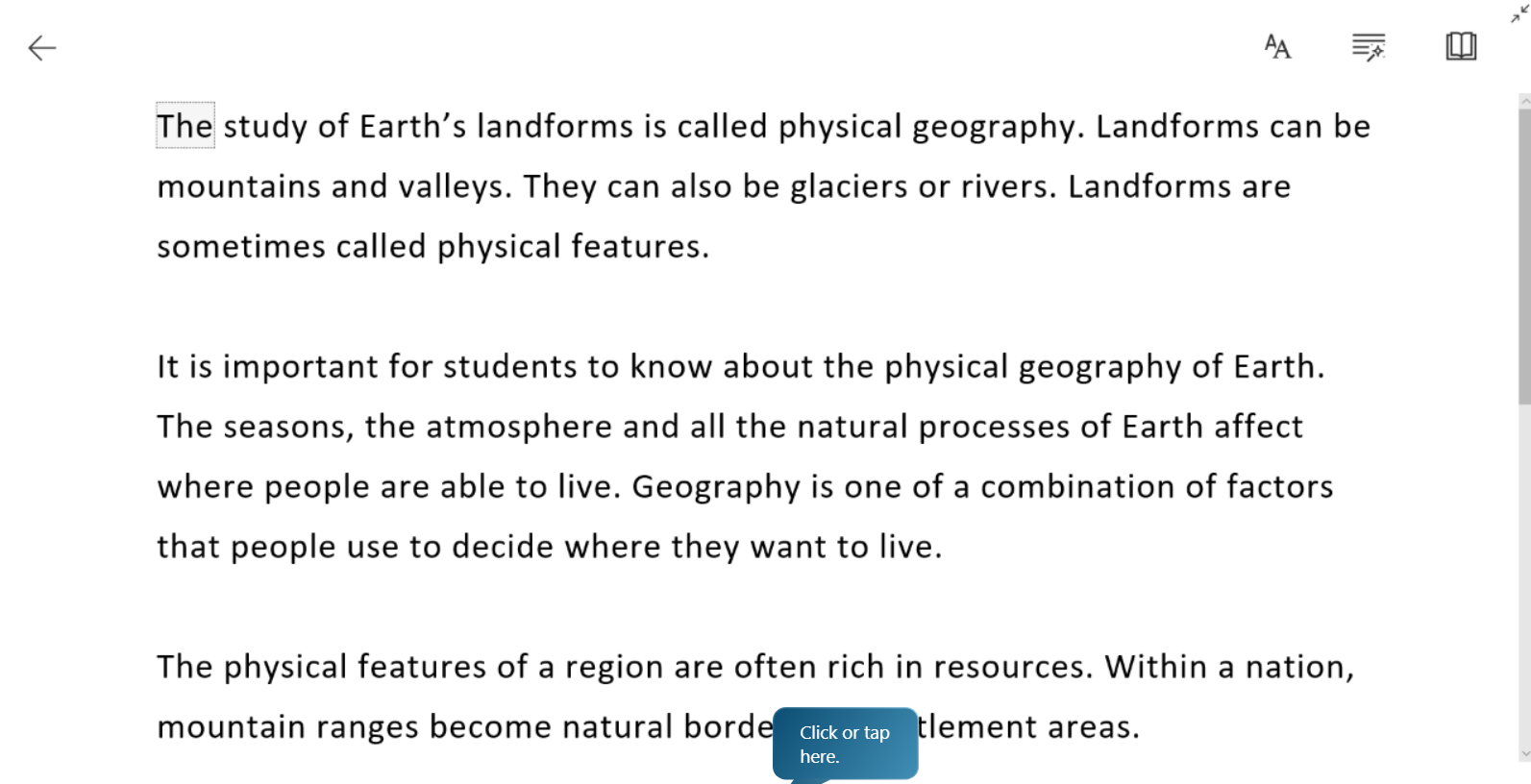
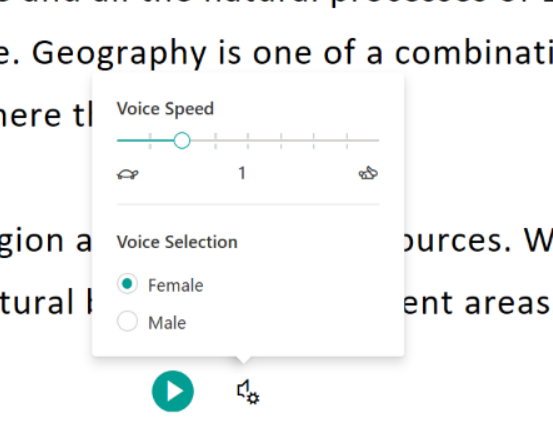
At the top of the screen Immersive Reader offers changes for text preferences, grammar tools, and reading preferences. The text preferences consist of things like changing the size of the text to allow the reader to make the text bigger or smaller, increasing the spacing between word in order to reduce crowding, changing the font to something the reader is more comfortable looking at, and changing the theme (background color) to whatever the reader prefers. I think all of these options are amazing. But this is just the beginning and Immersive reader offers so much more.
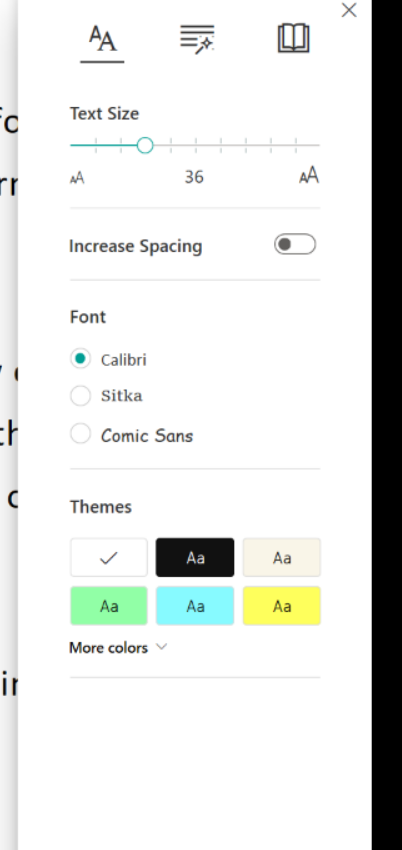
Immersive Readers next features are located in the grammar options tab. One of these options allow readers to breaker word up by syllabus. This allows them to sound out word. There is also a very cool feature that highlights the parts of speech in the text and will label them accordingly. I wish I had this when I was learning how to read. School House Rock will always be great, but this feels like it will be utilized often and will really allow readers to understand the parts of speech.
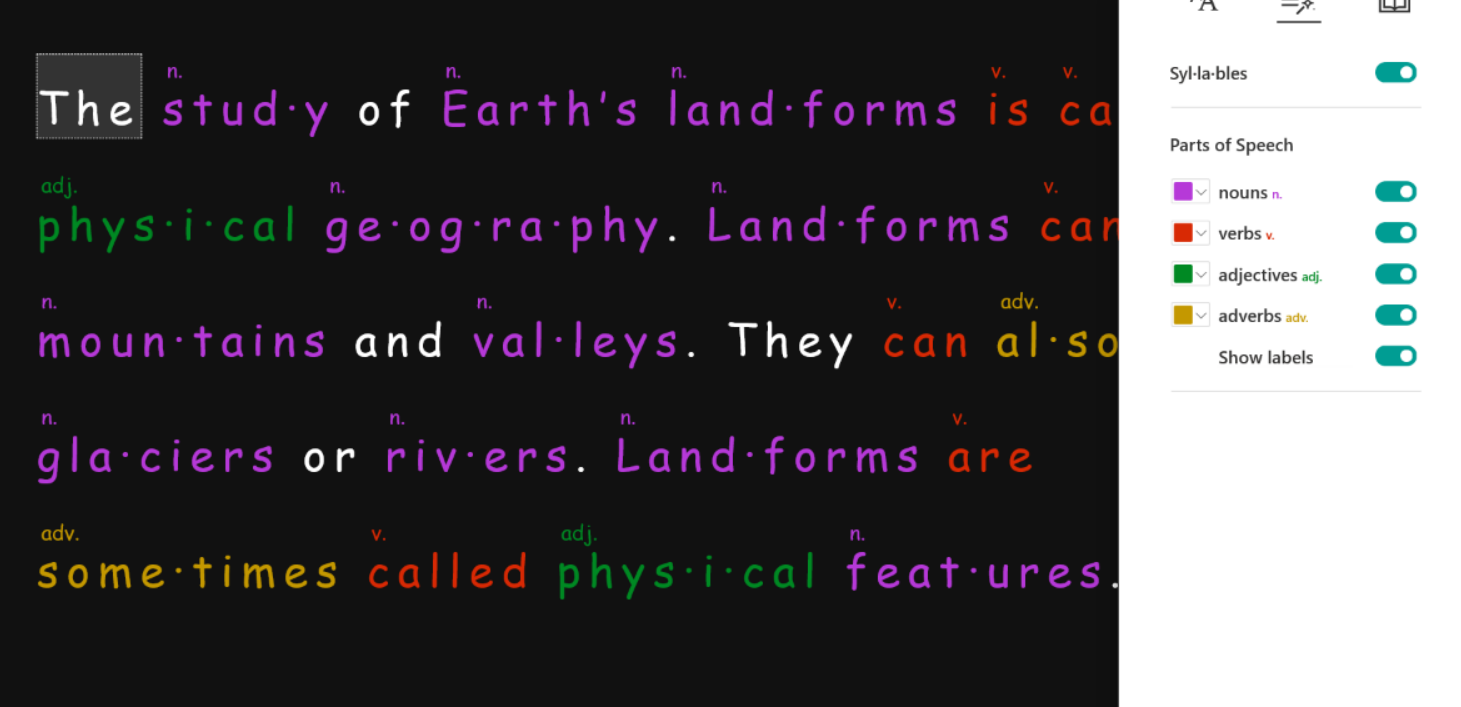
The last of the three options is Reading Preference. This reading option is really awesome. It can take one, three, or five line of text and focus them by making them brighter and muting the colors in the rest of the text. This feature can be used to help with eye tracking during reading and make sure readers are moving about the page correctly and not skipping sentences. Another feature in the Reading Preference tab is text translation. This allows the reader to look at different words and see what they are translated into a language of their choice, like French. The word that was chosen pops up with an image representing what that word means in real life when using the picture dictionary and the chosen word has the translated pronunciation as well as the original. If want to readers can translate the whole text; if they choose to do this there is a toggle option at the top of the page that allows the reader to switch between languages. This feature is incredibly useful when learning new languages!

One of the best things about Immersive Reader is that is very accessible. Because it’s been integrated into so many Microsoft tool like Word, OneNote, and the bowser Microsoft Edge, just to name a few, readers don’t need to be without these useful tools. With the Lens app people are able to take picture of signs and can then convert the image into a document that can access all of the features that are available in Immersive Reader. This tool is incredible powerful and will make it so people around the world are excited to read instead of dreading it. I look forward to using this with students in the future.
KitaabWorld
The website I decided to explore was KitaabWorld. It’s a great a place for finding books that represent South Asian literature. The home page has links to where you can purchase books; there is a recommended reading list that separates the books into different categories; author interviews, where you’re able to select an author and read some question and answers about their process/inspiration for their book. If you select Lesson Plan, you’re given a list of books that are filed under specific categories and have age ranges assigned to them, so you’re able to see if the book is the appropriate reading age for your class. One you choose a book there is a detailed lesson plan that can be implemented into your class.
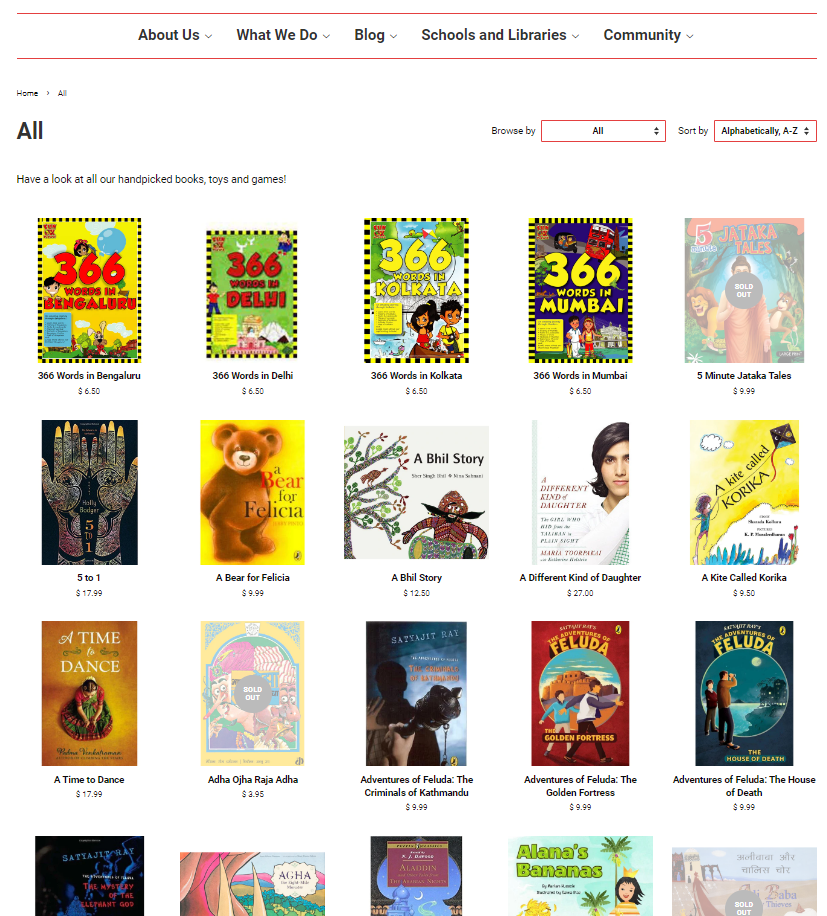

Above on the left you can see the collection of books that KitaabWorld has to offer, and on the right, you can see the books broken up into categories with a list of different categories going down the side. Below, on the left, is the lesson plans that are available. On the right is an example of a lesson plan.

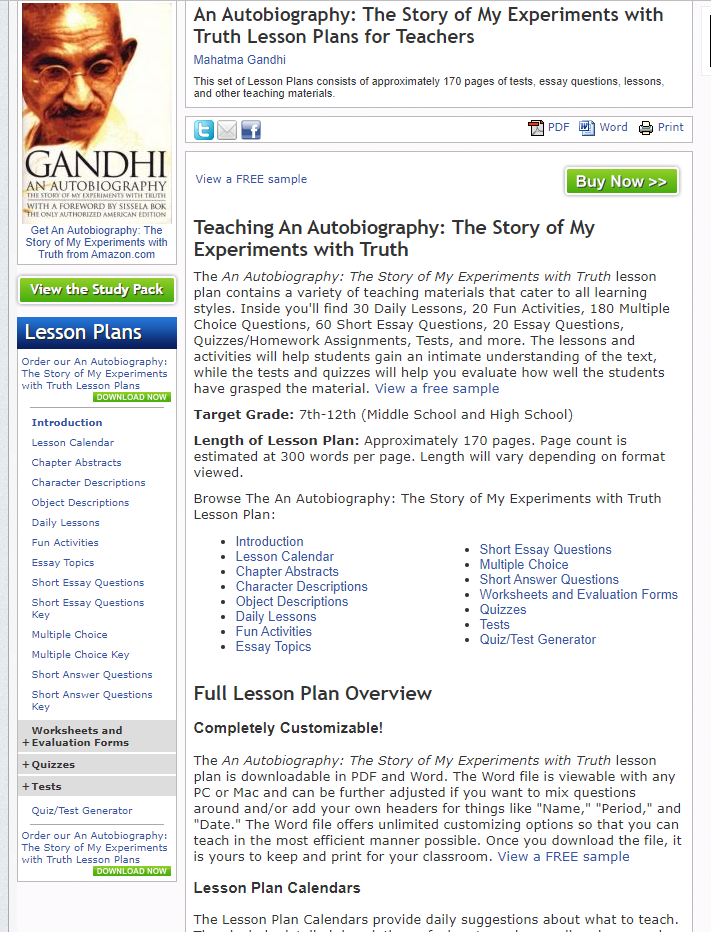
The lesson plan was pretty awesome. It was customizable and had suggestion on what could be taught about the book. There were sections that had short answer questions, and multiple-choice questions in the form of tests and quizzes. The website would link to other sites and the lesson plans depended on the website it came from and the age recommendation of the book. One of the lesson plans was simple compared to the one linked above. It went over the themes and setting of the book and had questions for the class about each. It also had two activities, the first was where the students could try and to spell and speak some common words and phrases in the Hindi language. The second activity was a recipe for baking a bread that was featured in the book. I think the lesson plan portion of the website is great because it can be accessed and used by teachers in any grade and there is a wide range of activities that are listed for each book to get students engaged with the source material.
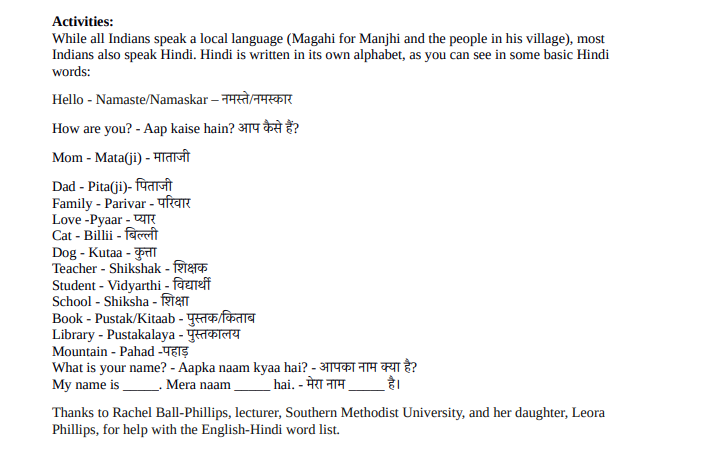
This website also has a mission to stop islamophobia. With its campaign Counter Islamophobia Through Stories, they try to change the stories and misinformation about Muslims. Teaching children about different cultures and showing them that it’s okay to be different at an early age is important. By learning about similarities and understanding differences through story telling we’re able to create an environment of respect and acceptance towards one another. The movement has books separated into different themes so that teacher, parents, librarians, and anyone else in the student’s life that helps teach and guide them through the different stories.
I think that this is a useful tool because of the 50+ categories the books are separated into, it allows you to go to the site and with an idea of what you are going to teach and pull a book from a list that is associated with the topic. Then once you have the book you can use lesson plans from the website to help educate your students in ways that you might not have thought of. I liked the lesson plans that incorporated activities that were not strictly educational, like the one I found about baking bread that was featured in the story or trying to say some words in Hindi. It makes the stories that are being learned about more applicable and gives students a way to connect to the stories. I think one thing that is important is make sure student take something away from what is being taught and I think lesson plans that can make learning more engaging and fun help to make that goal of understanding more attainable. In the future I look forward to implementing different activities to make lessons more engaging and enjoyable.
Collaborating for the Future
I found an article on twitter that goes over innovations that are being made in the world of education. As the world is advancing, we as educators, must advance with it to ensure that the future generations are getting a good education. By using our time wisely and not treating the summer as time away from the teaching profession we are able to keep up to date with new ways of teaching and our hone skills.
Some ways that we can expand our horizons are by connecting with others, innovating leadership, questioning why things are done a certain way, and encouraging students to use technology. By connecting with other we can expand out learning network, and if we use social media like twitter new ideas are only seconds away. Innovating leadership will allow for students to work together and create a shared vision. Questioning why things are the way they are helps build critical thinking skills that can show new perspectives and allows the students to be taught in a forward-thinking manner. Encouraging the use of technology allows students to engage with lessons in different ways and still facilitate a learning experience.
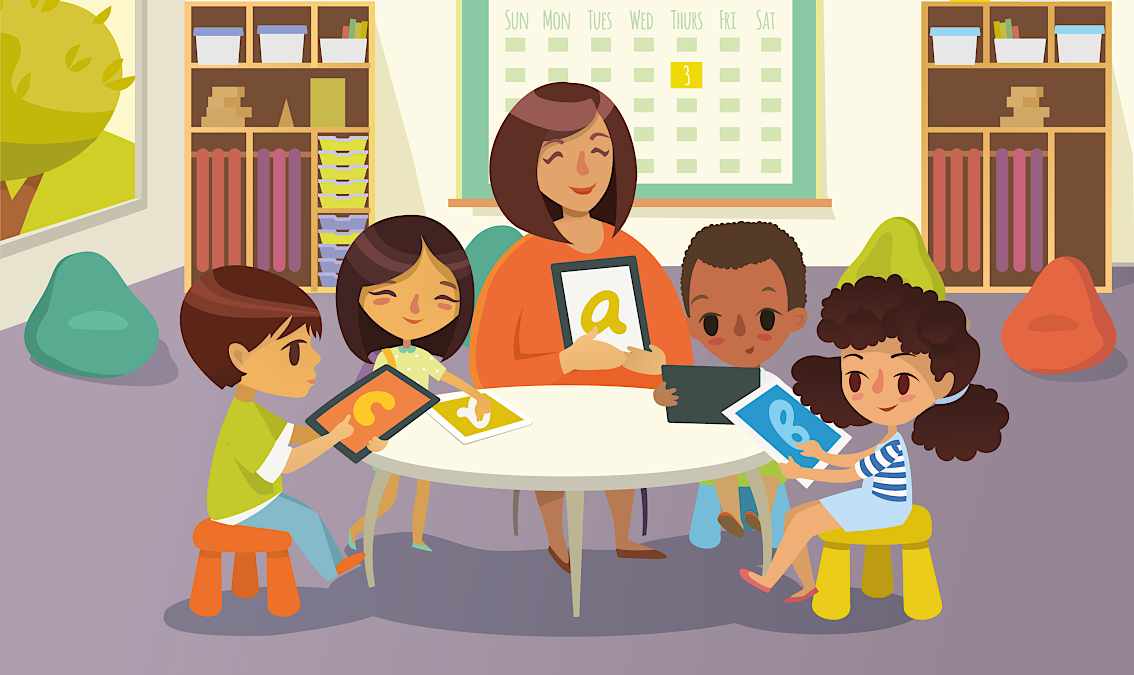
Everything in the article points to collaboration as the focal point of education moving forward. As teachers we can get together and talk about different ways we’re teaching. Then once we’ve tried them out, we are able to give feedback on what did and didn’t work; allowing us to improve lesson plans. Getting students to work together allows them to build collaborative skills that they will use throughout their lives and allows them to learn the lesson together.
A.I. Intergration
In an article I found about Artificial Intelligence, there is a discussion about how A.I. can be used to help the students and make the learning environment of all schools more accessible. Making it easier to communicate with students that are multilingual learners or students with disabilities. A.I. can be used to help students learn at different rates instead of going at a rate comfortable to the majority, with might be to fast or to slow for some learners. A.I. also has the ability to adapt to a student’s answers, instead of marking an answer to a question incorrect of correct, A.I. is able to adapt to a student’s learning process, these adaptations may allow the student to become stronger in the classroom by working with their strengths and finding ways to overcome weaknesses. To go along with not just marking a question right or wrong, A.I. can give feedback frequently in order to improve the teaching and learning experience.
The article also goes over the fact that teachers are not being replaced. It reminds us that we teachers are the ones applying A.I. to lessons and that when applied A.I. is going to be based on established, modern learning principles, use the wisdom of educators, and should use the expertise of educational assessment to improve fairness and detect bias.
I think the article points to two major problems that need to be overcome. The A.I. system producing inappropriate or wrong ideas that could amplify unwanted biases; and, strengthening the trust that educators have in A.I. and its ability to be used as a teaching tool. These two problems can be solved with time (teachers using A.I. and seeing how its functions can be applied and research and development of A.I. from the manufacture) and specific guideline set into place, dictating how A.I. can be used safely and appropriately in the classroom.
